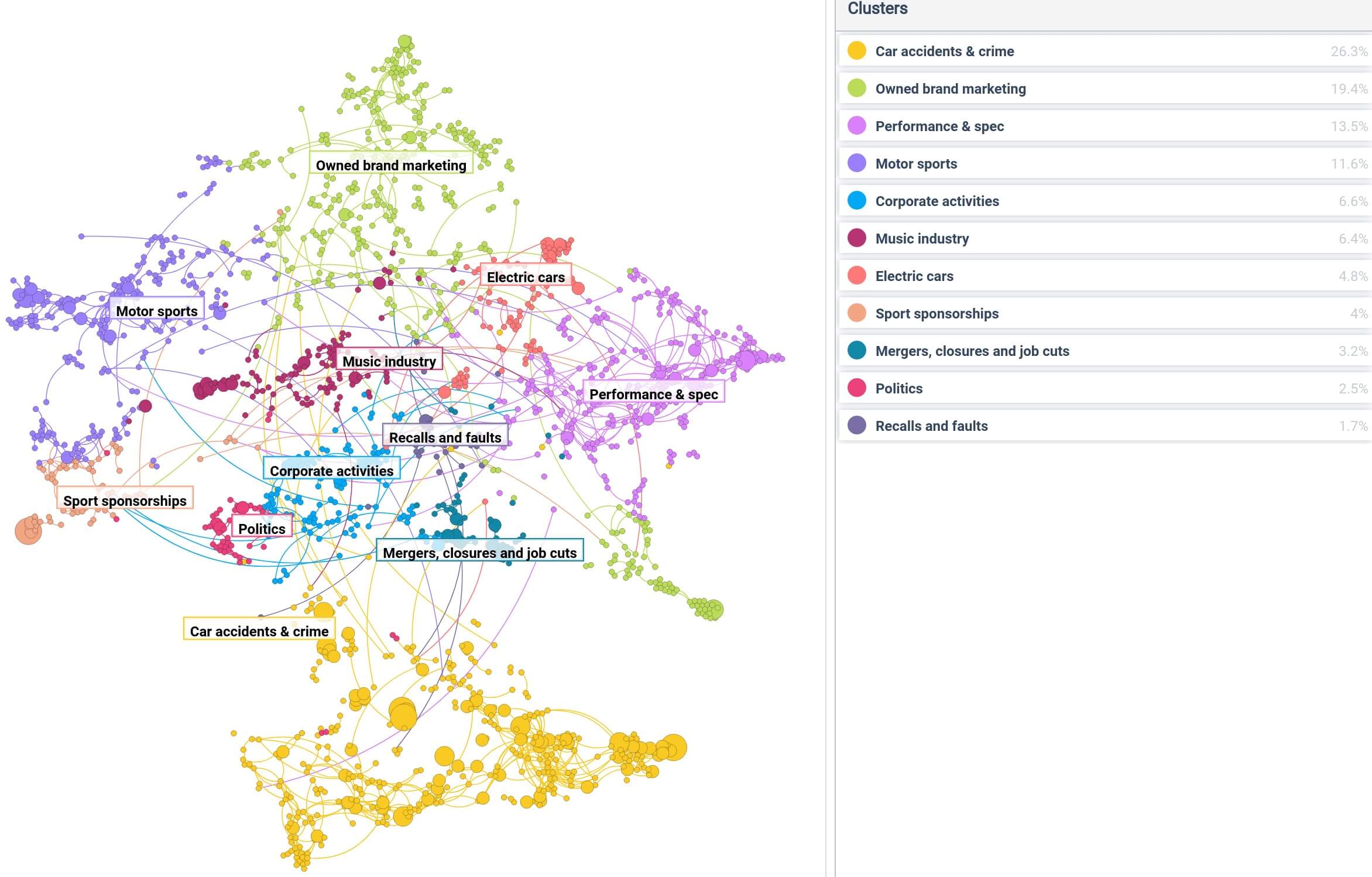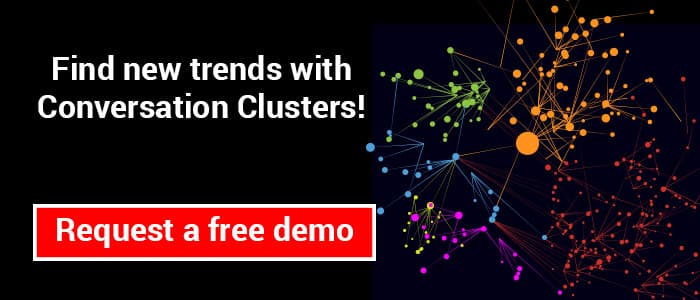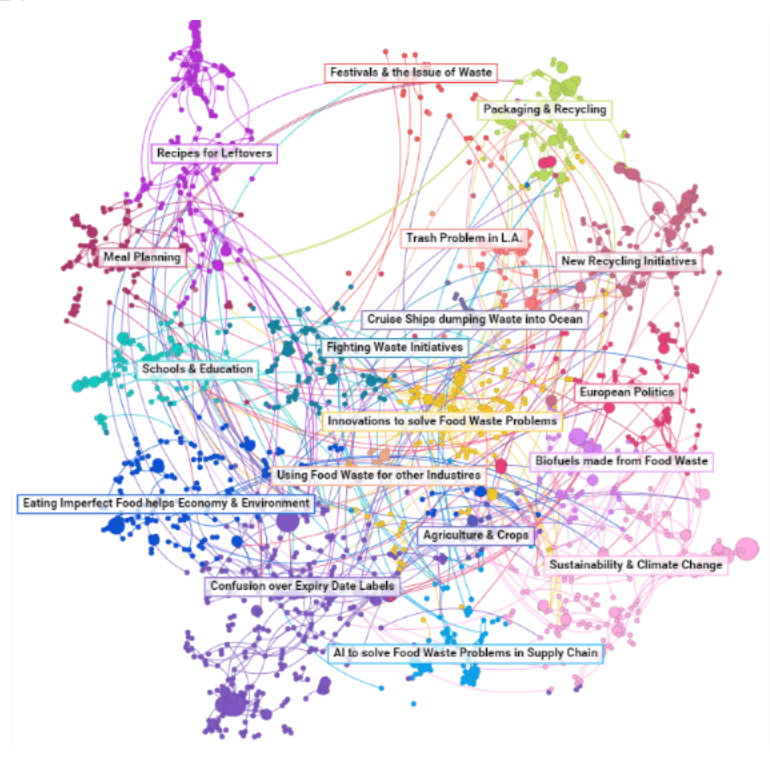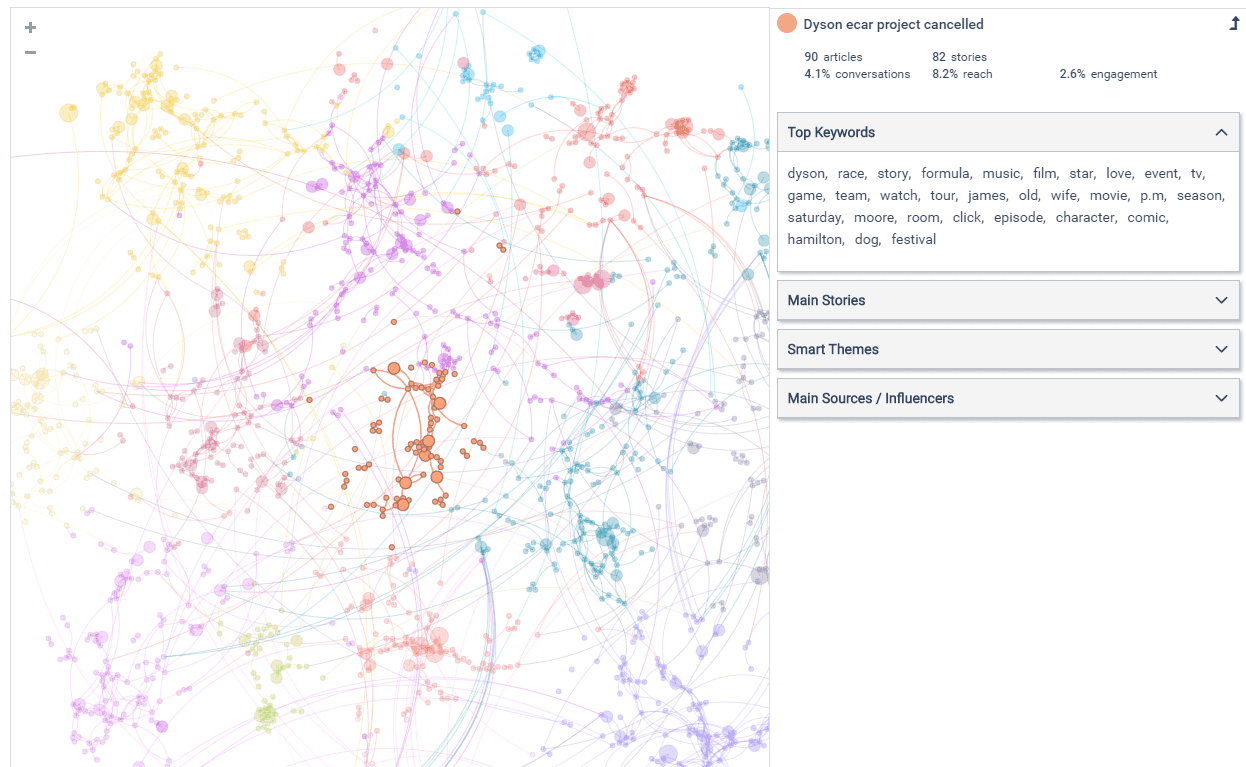Level up your trend research with Conversation Clusters Talkwalker
Trend research is getting harder. Welcome Conversation Clusters - predict trends, find awesome content ideas, and exploit consumer insights.
January 1, 2020

- What are conversation clusters?
- Product update - Conversation Clusters 2.0
- 1. Why macro trends are so important and how to leverage them
- 2. How to predict trends for content creation
- 3. How to use conversation trends and consumer insights to improve your communication
- 4. What trend research can do for more innovative product development
- How do Conversation Clusters work?
- What is the difference between word clouds and Conversation Clusters?
See Conversation Clusters in action
What are conversation clusters?
Conversation Clusters is a user-friendly data visualization tool that helps you instantly uncover, understand and visualize the context around any topic at a glance. As part of your social listening, it enables you to find meaningful trends, patterns, content, and connections for any topic, no matter the volume of results.
At the same time, it eliminates all those hours spent on manual research. By analyzing millions of results from media, consumer and social data in under a minute, it maps hidden patterns within any conversation or topic so you can focus on what’s important.
The best thing? There’s no need to be a data scientist to generate or analyze Conversation Clusters - you’ll be extracting crucial insights in a matter of minutes. Using the latest tech in machine learning research, you can map out the conversations behind your search in a few clicks, showing the context and connections behind your data points.
Let’s look at some examples to show you the potential of conversational intelligence for various industries (automotive, FMCG, beauty, telco, etc.).
Product update - Conversation Clusters 2.0
We recently updated Conversation Clusters to make them faster and easier to use. Here’s what we’ve added.
Quick set up
In the past, you needed to have established topic queries to create Conversation Clusters. These topics can take time to set up and are optimized with Booleans to get the best results.
Now, we’ve integrated Quick Search into the feature. So instead of setting up a topic, you can just analyze whatever you like instantly. Just type the word or phrase in the box, and away we go.
You can still optimize with Booleans and a range of filters, but if you want fast, easy insights, you can get them, with up to 13 months of back data.
Auto naming and description
Blue Silk™ GPT is Talkwalker’s latest AI innovation, bringing the speed and ease of GPT to social listening.
By applying Blue Silk™ GPT to Conversation Clusters, our AI now names all your clusters for you, with a simple description of what each topic cluster is about. In the past, users had to manually deep dive into each cluster to get the full picture. But not anymore.
This vastly reduces setup time, allowing you to take action on the conversations you discover instantly.
1. Why macro trends are so important and how to leverage them
Identifying macro trends can help you understand context. Let’s see how a music video trend can be an opportunity for the automotive industry.
No matter your line of business, you probably think you have a pretty good grasp on what’s going on in relation to your brand and competitors. You’ve set up alerts for your most important keywords, and you’re watching social like a hawk.
But sometimes, even in your own industry, you might not be aware of macro trends, and how you can use them successfully in your strategy. Brands are increasingly looking to cash in on these trends, and there’s a simple reason for it: talking about something that interests a lot of people and sparks meaningful interactions is more likely to make a strategy or campaign a success.
When you spend every day in the thick of it, seeing the forest for the trees can become a problem. How can you identify these trends? After all, millions of results and data points are only meaningful when you know what’s going on and you can act on these macro trends. That’s when looking at Conversation Clusters will work wonders.
Let’s look at a high-level example of Conversation Clusters for the automotive industry.

At first glance, this network shows significant conversations related to performance and car specs. There’s also a fairly large cluster about owned brand marketing, as well as discussions about motor sports and sponsorship.
Moving south of the center, there’s a high-volume cluster containing articles about car accidents and crime, but which remains disconnected from the rest of the conversations linked to this industry. In between, there’s some discussion activity about corporate topics, recalls and faults, and electric cars.
So far, so predictable.
Now, if you’re interested in any of these topics, you could start a deeper analysis by zooming into specific clusters to get a more granular understanding of the subject and its conversation drivers. But what stands out at this level already, is the music industry cluster.
It takes a central spot within the conversation about the automotive industry, suggesting it is connected to a lot of other topics around it. Why are there so many conversations linked to music? Digging deeper reveals that there’s a fairly large conversation bubble about cars that appear in music videos. These conversations are garnering a lot of comments, and there’s a number of cars that are regularly included in the lyrics of top hits.
How do you leverage product placements in music videos? How do you target the most relevant audiences? What are other ways to relate priority targets? Gather the insights that help inform your communication strategy, from social media posts to more engaging advertising and different forms of content.
Once you have identified this macro trend, dig deeper with a focused query to get more insights into other emerging trends in the industry.

2. How to predict trends for content creation
Predicting rising trends helps you find content ideas that resonate. Check out why ugly fruits are a big thing in food waste conversations.
Today, consumers care more and more about the origin of the products they’re offered, as well as the far-reaching consequences of their consumption choices. This is probably why the term “food waste” gained in popularity on Twitter and beyond throughout 2019, with a total of 694,000 mentions over that time frame.
But knowing the wider topic alone isn’t enough to create successful content. If you want your content to be timely, relevant and original, you need to get into the business of trend prediction.
Let’s have a look at a map of this topic:

Several of the emerging themes will confirm your intuition when it comes to food waste conversations, such as the interconnected topics of meal planning and recipes for leftovers. Yet didn’t you expect these food prep conversations to make up a bigger part of this cluster?
At the bottom, we find topics such as the confusion expressed by consumers when it comes to the expiration date of their products, or questions linked to the consumption of “ugly food” (imperfect food products such as misshapen vegetables or bruised fruits).
If you intend to write engaging content on this topic, this data visualization will help you understand the most engaging story angles, as well as the debate drivers and the relationship between the different subtopics. Leveraging data insights in your content creation will thus allow you to own the conversations in relevant connected clusters which have not been spotted by your competitors and help you establish your leadership in the topics you choose.
Surface powerful content ideas
3. How to use conversation trends and consumer insights to improve your communication
Knowing what customers really care about elevates your communications. Here’s how a major telco brand took its product launch to the next level with the help of conversational intelligence.
You just got the go from your R&D department: your product launch date is confirmed, and you still have a few weeks to tweak your communication plan. How can you use this time to take your product launch from good to great?
For a telco brand, the answer was using Conversation Clusters to elevate their market research. Listening to what consumers are saying about similar products, figuring out what their pain points are and paying attention to shifting trends in opinions can be crucial in a successful launch campaign.
In this case, in preparation for the launch of its new Internet box, the brand’s customer insights team analyzed all market conversations related to the product amongst its own customers, along with all direct and indirect competitor boxes. What were the specific issues encountered by the average consumer in their daily use of this type of device? How could these be addressed throughout the product launch?
Filtering results such as showing only negative sentiment discussions allowed the brand to zero in on specific pain points, while analyzing positive clusters helped them refine their communication by emphasizing features that people really loved.
Mapping the entire context of the discussion with Conversation Clusters this way allowed them to improve the product sales briefs for the brands’ vendors and the advertising materials, as well as to create FAQs and other resources that addressed the most common issues that had been identified.

4. What trend research can do for more innovative product development
If a trend analysis doesn’t take weeks, you can go to market fast with a product that customers love. Such as this beauty brand that used market insights to develop a unique product.
In the social media era, beauty fans are more informed than ever, and are always on the lookout for their next favorite product. These consumers follow influencers, discuss issues on forums, and share their comments and solutions with their communities.
A globally recognized beauty brand used this wealth of information to analyze business profiles from Instagram influencers from different regions of the world, in order to forecast trends in foundation, mascara, lipsticks and skin care products.
Using Conversation Clusters, they realized that the volume of conversations about moisturizing products with added SPF on the European market was lower than in other regions, and that customers had a specific problem with the available products: stickiness.
Armed with that information, they developed a product with a different and lighter texture that fit the insights they had extracted from these conversations. Then they identified the local micro-influencers who had been most vocal about the problem before and developed a campaign that included sending them samples.
How do Conversation Clusters work?

Legacy query solutions take time to build and you need to know what you’re looking for. The algorithm behind our Conversation Clusters can group vast numbers of articles in minutes and find hidden connections that might not be apparent to analysts from the outset.
“The algorithm identifies relevant word patterns and semantic structures in the results and then plots them in a way that related conversations are shown close to each other”, explains Dr. Benedikt Wilbertz, Head of Data Science at Talkwalker.
“This way, it builds groups of discussions covering similar subjects by discovering their common themes and showing how they relate to each other. Using the latest advances in machine learning research and a massively parallel infrastructure, we are able to analyze and represent tens of thousands of conversations in little more than one minute.”
Here are a few tips which will allow you to extract even more value from this data visualization:
Similar articles cluster together to form bigger conversation dots.
Wide clusters are more controversial or discuss broader topics.
Clusters in the middle of the visualization are better connected with the overall conversation.
Niche conversations happen on the edge of the map.
What is the difference between word clouds and Conversation Clusters?
A word cloud identifies the most commonly used words or expressions linked to a specific query. You may have some indications as to the frequency at which these words are used based on the size of these words.
Conversation Clusters take your analysis to the next level by mapping out the hidden connections between the different topics present in your search. Rather than being summed up in a single word, the information is put in context, and you have the option to zoom into the cluster to identify specific articles.
Whether you want to find trends, write trending content, or use consumer insights to make the best products, Conversation Clusters will help you predict future developments that matter for your niche.

